Couches and hide-a-beds are some of a householder’s major purchases. They’re usually worth many hundreds or even thousands of dollars and they’re very difficult to move because they are big and heavy. So it is wise to fully protect them to avoid damages during moving and hire professional movers to take proper care of your cherished furniture.
How to Pack Cushions for Moving
The first thing you’ll need to do before getting the couch ready to move is to protect the cushions.
One of the best ways to ensure the safety of your cushions during a house move is to stack them as shown in the picture, fully wrap a pad or two around them, and tape the pad(s) into place.
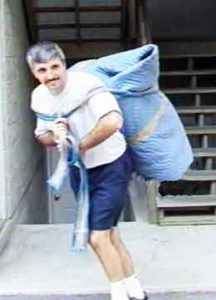
Your mover can then strap the padded cushions to his/her back and carry them safely and easily to the moving truck.
Carrying them in front is not as safe because the large bundle obstructs the mover’s field of vision.
Another way to protect couch cushions is by putting them into doubled up, thick, large plastic garbage bags. Remove all cushions and arm and back coverings from the couch and tape seal them safely in plastic bags. When cushions don’t seem to come off, there is probably a zipper, or sometimes Velcro, attaching them.

This is a simple and inexpensive way to protect and transport sofa cushions.
You are however advised to also put the bagged cushions into a big box (or boxes) for better protection.
You can also just plastic wrap cushions as shown below.

Professional movers put plastic wrapped or bagged cushions into large wardrobe boxes to further protect them and to keep them clean during the move.
Smaller cushions can also be used as top or bottom of the box liners for fragile items like vases.

Padding your Couch
With the cushions safely removed you can begin to pad the sofa to protect it.
The time and effort you put into fully padding your couch will pay off when you have to set the sofa down in the process of carrying it, just because of its weight and its bulkiness.
Many times, it won’t be possible to set down the couch onto its feet.
You’ll probably have it standing up on its side, with one end on the ground or the floor as in the picture below.
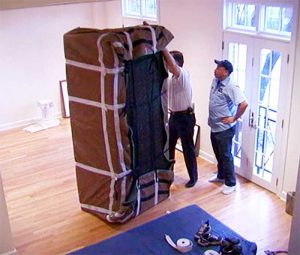
Outside, setting a couch down on the ground unpadded could cause grass stains or soiling, and could even result in tears to the couch (if it is put on an unnoticed rock, nail, or piece of broken glass on the ground).
Padding also protects a couch from one of the hard to spot dangers that you might encounter when carrying a big, heavy piece covered in fabric – protruding sharp objects!
A protruding nail or a splinter from the wood of your porch railing, or maybe even your belt buckle, can produce a large, ugly tear in the couch’s fabric. This is another good reason to fully pad your furniture.
Be sure to use plenty of tape around the pads to secure them in place – otherwise, the padding may slip while the couch is being moved and result in personal injury or damage to the sofa.
To pad the sofa correctly, place a suitable protective covering on the floor. Then carefully lift the couch and set it onto the pad.
Center the sofa on its arm on the pad.
If possible, unscrew the sofa’s legs to make the piece easier to squeeze through doorways and narrow corridors. Wrap the legs separately and mark them to know what piece of furniture they came from.
Then take another pad and place it over the raised sofa arm as shown in the picture. Neatly square it off, fold it over the arm, and secure it with tape.
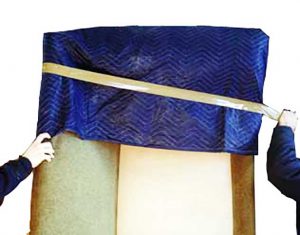
Be careful not to let the adhesive touch the couch itself, just the pad.
Make sure you apply the tape snugly. Have a knife or sharp object on hand to cut the tape but be very careful to not slip and cut into the couch!
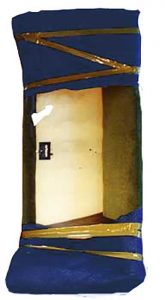
Now, flip the couch over and pad the other side in the same way as shown in the picture above.
When you are done doing this, check the pads and tape to make sure they’re snug and secure.
The final optional step is to put one or two more pads all the way around the unpadded center of the sofa, front and back.
This step is done in order to fully protect the sofa. The center pad should overlap the side pads to fully shroud the sofa.
Be sure to wrap tape all the way around the sofa working your way down to the other arm pad.

A fully padded, well-protected sofa will look like the one in the picture above. Notice the generous use of tape to secure the pads so that they don’t come loose during the moving process.
With this kind of
Also, when the couch is on the truck the padding protects it from rubbing damage from other pieces as the load bounces along. Rubbing against other items can act like sandpaper and scar a piece, even through a pad.
When all the furniture is fully shrouded in pads, one piece’s padding will only harmlessly rub against another’s during transport.
Below is a picture of a number of big, well-padded pieces loaded onto a truck. None of these pieces will sandpaper another because they’re all very thoroughly padded.
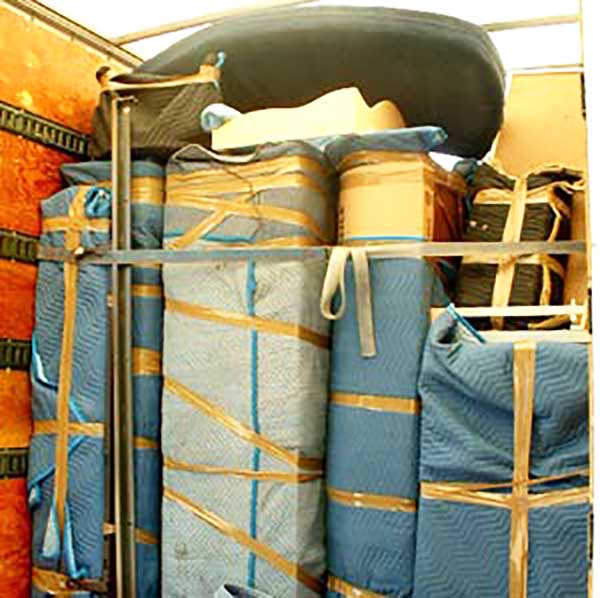
Padding a Hide-a-Bed for Moving
Hide-a-beds (Sofa-beds) are heavier than regular couches because of the heavy steel bed mechanism and mattress hidden within them. Therefore, you need to remove the mattress and secure the bed mechanism before you wrap the sofabed for moving. You can find more information on how to tie-down the bed mechanism here.
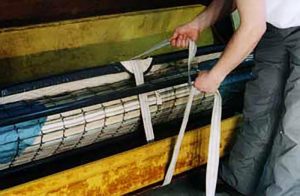
When you do this, your sleeper sofa will be ready to be blanket wrapped for moving just as is done when moving a couch.
So, place a pad on the floor and lift one end of the couch onto it.

So its easier to pad hide-a-beds while they’re left standing on their feet rather than when they’re tipped up on their side as was done with the couch.

So just fold the pad up over the arm, the back, and the front of the hide-a-bed and tightly tape it as shown in the picture above.
Then drape a pad over the middle and place another pad on the floor under the other end as shown in the picture below.
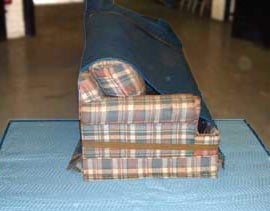
Next, fold that pad and tape it over the arm and the back as was done on the other side.
Adjust the middle pad so that it is overlapping both end pads and secure everything with tape as shown below.
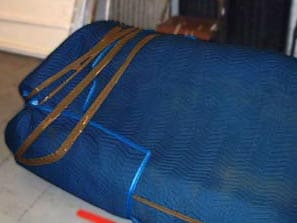
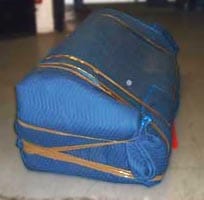
Your hide-a-bed will be securely padded and ready to be lifted, carried and set down damage free anywhere!
If the fully padded sofabed has to be set down in the dirt or grass or on concrete or blacktop the pads will pick up the grit or stains, not the couch.
Before being put onto the truck or into the new residence the couch can be flipped up and over to brush any dirt or grit off of the pads.
A fully padded couch also provides extra grip for the movers as long as there are plenty of tape windings around it.
This taping holds the pads firmly in place under the strain of being gripped and carried.
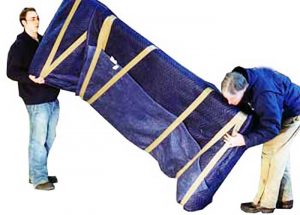
So now the couch or hide-a-bed can be tipped up from either side and lifted and carried around by two men.

Moving a Sofa or Hide-a-bed
Couches and sofabeds are big and difficult to handle, especially because sometimes people can’t even see each other to communicate as they’re carrying it.
Using a 4 wheel dolly under the back of the hide-a-bed or under one of its arms (if you stand it up) to move it along level ground makes it easier to transport and helps save strength until it must be carried.
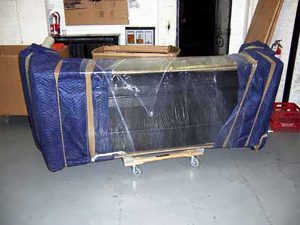
At least two strong people are needed to safely carry a couch or a hide-a-bed.
When carrying such a heavy furniture piece up/down stairs, a third man might be used on the lower (heavy) end as the couch is being taken up/

When traversing straight stairs with landings, the movers must plan the couch’s initial position at the bottom/top of the stairs so that the sit-down ‘L’ shaped inner area starts out facing the railing and the turns as displayed in the picture below.
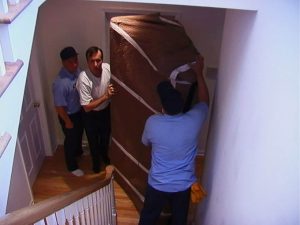
Proper initial positioning makes carrying a couch up/down stairs much easier because the movers can take advantage of the couch’s geometry to simplify the turning process on the landings.
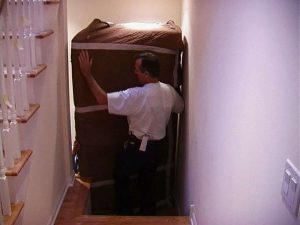
When going up/down stairs, the mover(s) positioned on the bottom of the couch are carrying the majority of the weight and they’re somewhat pushing/pulling the top person as he guides his end of the couch so as to not damage the walls, ceilings or railings. A
Going up the stairs, as the landing is encountered, the top of the couch must be lifted up high enough so that the bottom can be scooted in and onto it. This is not always easy to do! So if there is room, sometimes two men are needed on the top as well as on the bottom to help safely complete the task.
Going down the stairs, the movers must get the couch positioned completely upright on its end first.
Then the bottom men pull the couch’s bottom to suck it off of the landing as it’s started down.
At the same time, the top mover(s) guide it down by tipping it back towards them from its stand up position, gradually tilting it until it’s low enough to be gripped on the top end and carried at an angle.
At the landing the couch is set down on its end and stood up.
Once the couch is on its end on the landing, it is twisted it around for the next trip up/down the next flight.
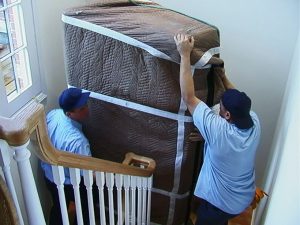
Notice how the proper initial positioning of the couch has made it possible to easily twist it around each of the turns on the landings. If you were to try to carry it with the back of the couch facing the turns you might not be able to make all of the turns. In that case, when you end up encountering the impossible turn, you’d have to take it back and start all over, thus tripling your work!
Sometimes the couch will not fit on the landing and also make the turn because the landing is just too narrow. In that case, it has to be lifted straight up into the air and turned while it’s airborne and then set on the first or second stair above the landing in order to proceed. Vice versa in that situation coming down. This requires one man behind and one in front of the couch to pick it around the turn.
It is a difficult and risky job that is best left to the professionals.


